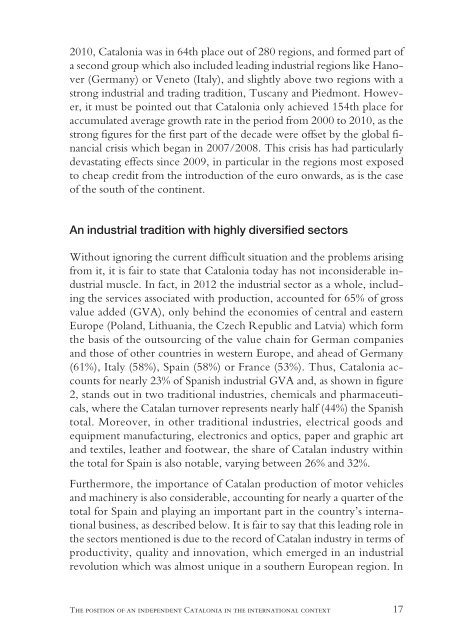The Economy of Catalonia
the_economy_of_catalonia._questions_and_answers_on_the_economic_impact_of_independence
the_economy_of_catalonia._questions_and_answers_on_the_economic_impact_of_independence
You also want an ePaper? Increase the reach of your titles
YUMPU automatically turns print PDFs into web optimized ePapers that Google loves.
2010, <strong>Catalonia</strong> was in 64th place out <strong>of</strong> 280 regions, and formed part <strong>of</strong><br />
a second group which also included leading industrial regions like Hanover<br />
(Germany) or Veneto (Italy), and slightly above two regions with a<br />
strong industrial and trading tradition, Tuscany and Piedmont. However,<br />
it must be pointed out that <strong>Catalonia</strong> only achieved 154th place for<br />
accumulated average growth rate in the period from 2000 to 2010, as the<br />
strong figures for the first part <strong>of</strong> the decade were <strong>of</strong>fset by the global financial<br />
crisis which began in 2007/2008. This crisis has had particularly<br />
devastating effects since 2009, in particular in the regions most exposed<br />
to cheap credit from the introduction <strong>of</strong> the euro onwards, as is the case<br />
<strong>of</strong> the south <strong>of</strong> the continent.<br />
An industrial tradition with highly diversified sectors<br />
Without ignoring the current difficult situation and the problems arising<br />
from it, it is fair to state that <strong>Catalonia</strong> today has not inconsiderable industrial<br />
muscle. In fact, in 2012 the industrial sector as a whole, including<br />
the services associated with production, accounted for 65% <strong>of</strong> gross<br />
value added (GVA), only behind the economies <strong>of</strong> central and eastern<br />
Europe (Poland, Lithuania, the Czech Republic and Latvia) which form<br />
the basis <strong>of</strong> the outsourcing <strong>of</strong> the value chain for German companies<br />
and those <strong>of</strong> other countries in western Europe, and ahead <strong>of</strong> Germany<br />
(61%), Italy (58%), Spain (58%) or France (53%). Thus, <strong>Catalonia</strong> accounts<br />
for nearly 23% <strong>of</strong> Spanish industrial GVA and, as shown in figure<br />
2, stands out in two traditional industries, chemicals and pharmaceuticals,<br />
where the Catalan turnover represents nearly half (44%) the Spanish<br />
total. Moreover, in other traditional industries, electrical goods and<br />
equipment manufacturing, electronics and optics, paper and graphic art<br />
and textiles, leather and footwear, the share <strong>of</strong> Catalan industry within<br />
the total for Spain is also notable, varying between 26% and 32%.<br />
Furthermore, the importance <strong>of</strong> Catalan production <strong>of</strong> motor vehicles<br />
and machinery is also considerable, accounting for nearly a quarter <strong>of</strong> the<br />
total for Spain and playing an important part in the country’s international<br />
business, as described below. It is fair to say that this leading role in<br />
the sectors mentioned is due to the record <strong>of</strong> Catalan industry in terms <strong>of</strong><br />
productivity, quality and innovation, which emerged in an industrial<br />
revolution which was almost unique in a southern European region. In<br />
<strong>The</strong> position <strong>of</strong> an independent <strong>Catalonia</strong> in the international context 17


